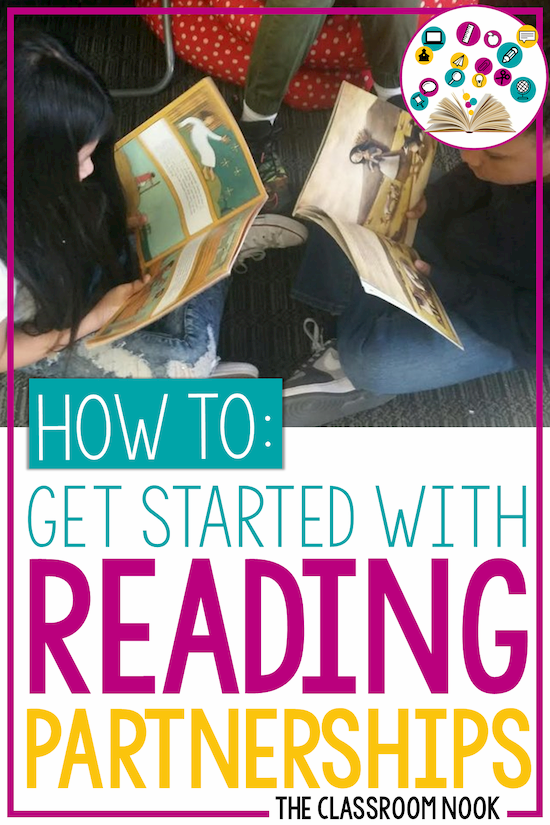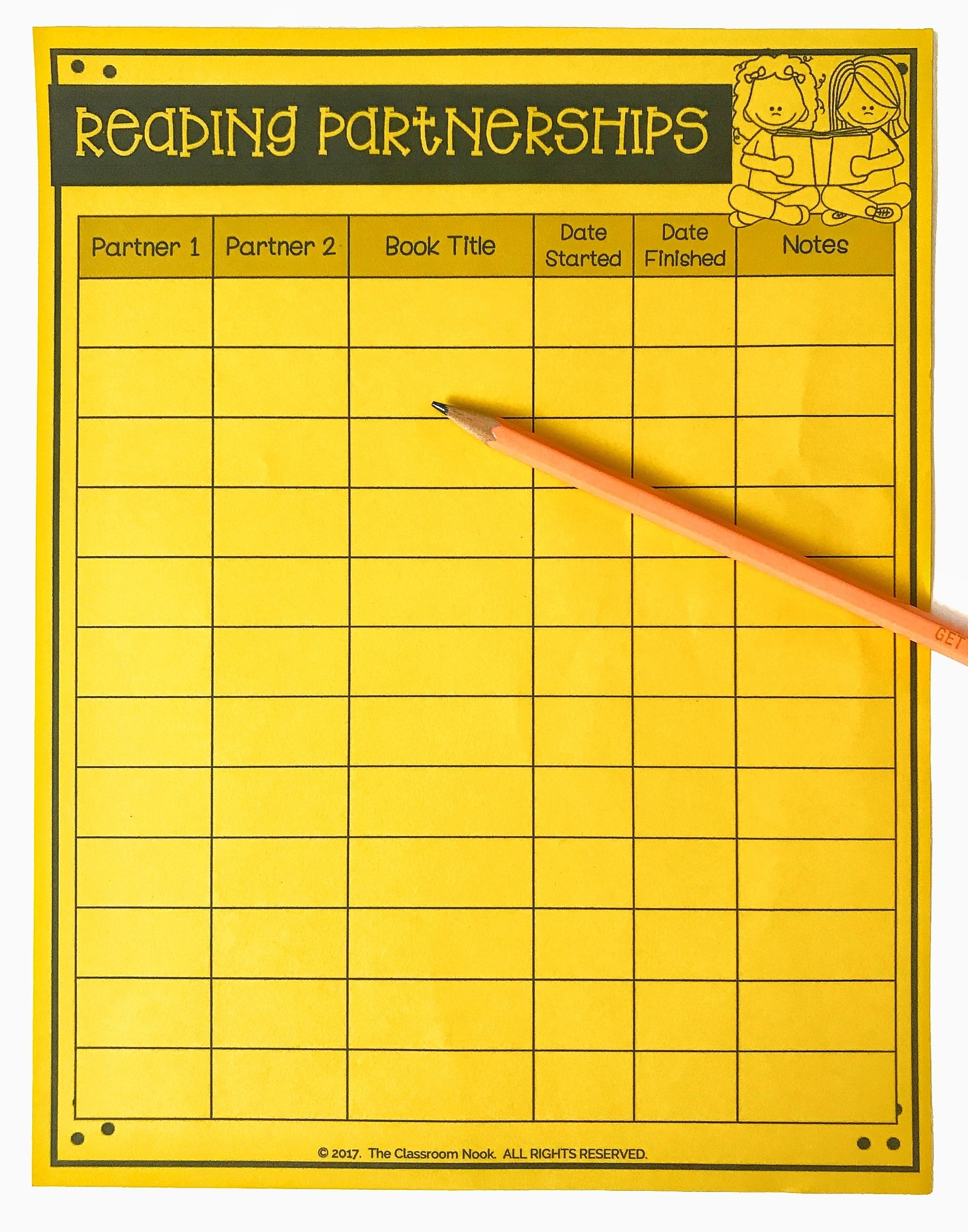How To: Get Started With Reading Partnerships in the Upper Elementary Classroom
Love podcasts? Check out this post in the form of a podcast episode on The Classroom Commute Podcast:

If you've been teaching for all of 3 minutes, you're likely familiar with buddy reading.
The idea behind buddy reading is great and can definitely be used effectively if taught correctly and practiced over and over with intention.
However, too often, time spent buddy reading lacks purpose and can easily turn into wasted time in the classroom. In my experience as a teacher, I've found that if I didn't explicitly set the purpose and intention for an activity in my classroom, I might as well have not done it. Students don't assume our purpose and therefore don't know what we are expecting from them unless we tell them.
Let's think about the reasons WHY we want our students to buddy read. Primarily, we want our students to have authentic fluency practice, right? We also hope that by using buddy reading in the classroom, students will engage in meaningful discussions about the book.
These are both good reasons, but sometimes we don't relay this purpose to our students. We send them off to buddy read and hope for the best.
If you're wishing that the time your students spend buddy reading in your classroom was time better spent, then you may want to consider implementing reading partnerships in your classroom.
What's the difference between traditional buddy reading and reading partnerships?
Buddy reading is often assigned on-the-go without much preparation ahead of time. On the flip side, careful preparation is needed for successful reading partnerships.
Reading partnerships take into account the reader's interests and abilities in order to form a partnership, whereas buddy reading often does not focus too much on the pairing of students.
In buddy reading, most of the reading is done together, leaving less time for conversation and text analysis. Reading partnerships, however, encourage students to do most, if not all of the reading on their own and spend their time together discussing the book using helpful guidelines. Fluency practice can also happen in reading partnerships as well when partners reread their favorite parts of the book to each other.
In the first post of this 2-part series, I'm going to give you the foundations of what a reading partnership is, how to get your classroom ready for it, and how to get your students ready to participate in reading partnerships.
In part 2, we'll dive in a little deeper into how to make them successful in your classroom.
WHAT IS A READING PARTNERSHIP?
With reading partnerships, students are paired up with other students who have similar reading abilities and interests. Each partner has their own copy of a book that the partners agree upon. For older students, partners typically choose chapter books, while younger students can choose picture books.
Partners spend time reading the book both individually as well as together. The majority of the reading will be done individually, and the time spent working together will be used to reread their favorite parts, discuss important details, ask each other questions...etc. Partners will meet with each other 3-5 predetermined times during the reading of the book.
When students complete their books, they can complete a reading project together that they can then share with their classmates (more on this in part 2). Reading partnerships can be an on-going process in your classroom that students flow in and out of. You do not need to be worried with having all of your students starting and finishing partner books at the same time. Instead, students work through their books at their own pace.
There will also be times during the year where you will want to take breaks from reading partnerships to pursue other reading projects. Reading partnerships are designed to be just ONE component of a complete reading program, and used when appropriate.
SETTING UP READING PARTNERSHIPS:
The first order of business when implementing reading partnerships in your classroom is to set up a special area in your classroom library where you can house duplicate copies of books that you approve for reading partnerships.
Look within your own collection of books for double copies and pull them out for this special area in your classroom. You can easily keep these duplicate copies together by wrapping them in a rubber band, that way they won't get separated. You might even want to place matching stickers on each book so that students know that these books are part of the "duplicate copies" section of your library.
You want to make sure that you have a collection of quality books that promote higher-level thinking and will support deeper conversations.
If you don't have a large selection of duplicate copies of books in your classroom, then you can always arrange a time with your school librarian to help students find books that your school has more than one copy of.
That being said, if reading partnerships are something that you want to continue in your classroom, be sure to always be on the lookout for double copies of popular books found at used book sales, Scholastic Book Club orders, and book sales at your local libraries. You can even refer to amazon.com to look for used copies of popular books. Over time you can develop a well-stocked duplicate-copies library.
Preparing Your Readers:
You will want to hold off implementing reading partnerships until you have had a good amount of time to get to know your students as readers. Once you're more familiar with the reading abilities and interests of your students, you can begin pairing your students together based on those abilities and interests.
Keep track of student partnerships and what they are reading to help you stay organized using a sheet like the FREE one shown left - available in my Reading Partnership Starter Kit (scroll down to grab it!).
You might consider having students complete a reading survey (like the one below) to help you better understand individual student interests. This survey can then help inform your decisions for pairing students together. (Note: Later on in your year you may choose to have the students select their own partners, but at the beginning it's helpful to make sure these partnerships are a good fit.)
Once you've been able to pair your students, give them some time to quickly meet with each other to discuss their reading interests. Ask them to discuss their favorite reading genres, authors, topics they enjoy reading about, favorite book series...etc.
Before having students choose their books, conduct a mini-lesson sharing some tips and strategies for previewing a book to make sure it is a good fit for them (Is it the right reading level? Does the title interest us? What can we learn from the back-cover summary...etc). Model this thinking process out loud for your students so that they get a sense of what the preview process looks like. Once they are ready, invite partners to choose a book from the duplicate copy section of your classroom library OR from your school library.
GETTING STUDENTS STARTED:
When each partnership has selected their books, you may find it helpful to meet briefly with each group to approve their selection, especially at the beginning when they are developing their skills for selecting appropriate books.
Students will begin their partnership with an initial meeting where they can make predictions about what the book will be about, discuss other books they have read by the author...etc. You may also choose to have your students read the first few pages together as they get started. It may also be helpful to give students a guideline to follow when conducting their meeting. They can use it like a checklist to go through during their time together.
The guideline for their first meeting may look like this:
What do you think the book will be about?
Have you read any books by this author before?
What about the title/front cover image grabs your attention?
What page of the book will we both read to before we get meet again? (Students will need to select a number of pages or chapters that they will read to so that they are both at the same spot of the story before they meet again. If reading a picture book, students may agree to read the entire book before meeting. They can then reread the book together, if desired.)
Students will then spend some independent reading time both at school and at home reading the agreed amount of pages before they meet with their partner again. Help them keep track of the pages they are to read by giving them a special partnership bookmark (see left) where they can mark it down. It's important to note here that students may have other books that they are working through in addition to their reading partnership book. If one partner finishes their pages first, they can read their other books until it is time to meet with their partner.
When the partners meet is up to you. Depending on how you set up your reading block in your classroom, you may decide to have specific dates in your reading schedule allotted for partnerships to meet, or you can allow them to meet as they finish each section of their book.
If you plan time in your schedule for all partnerships to meet at the same time, be sure to let your students know ahead of time so that they can have all of their reading complete in time.
If you choose to allow students to meet on an "as needed" basis, be sure to tell them appropriate times for them to meet such as right away in the morning, at the beginning of your reading time, or any other teacher-approved time during the day.
Again, you may want to provide guidelines for their discussion:
Tell a summary of what we have read so far
Share/reread your favorite parts
Share questions, thoughts, and insights about the characters and plots
Make predictions about what will happen next
Agree on what pages will be read before the next meeting
Putting these guidelines in writing for students to refer to may help keep students on task during their discussion. A simple sheet, like the one below:
free reading partnership starter kit
Forming reading partnerships is more than just buddy reading. It's partner reading with intention and purpose! Want to build a strong community of readers in your classroom?
Grab this FREE starter kit to help you establish meaningful reading partnerships between your students!
READY FOR MORE???
Go straight to PART 2 of this mini-series: STRATEGIES FOR STRONG READING PARTNERSHIPS
You’ll get actionable strategies for teaching your students to develop meaningful and organized discussion skills for successful reading partnerships!
But before you go, don't forget to grab the FREE resources mentioned throughout this post to help you get set up. CLICK HERE to grab them now!






